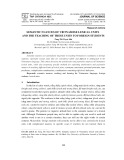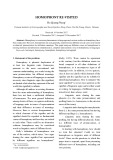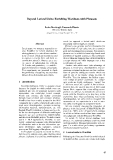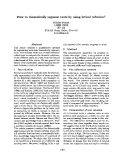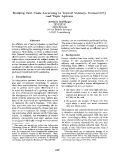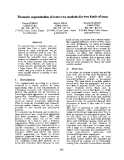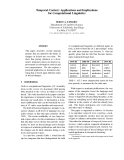
Different lexical units
-
This article discusses the ameliorative and pejorative nuances of Vietnamese lexical units, while also proposing specific methods for exploiting ameliorative and pejorative nuances in teaching different kinds of lexical parts: Synonyms, unit nouns, personal pronouns, state predicates, reduplication combinations, combinations containing high-level indicators.
 11p
11p  vihermes2711
vihermes2711
 01-10-2019
01-10-2019
 10
10
 0
0
 Download
Download
-
Homophony is a common phenomenon in languages and various studies on homophony have been conducted. However, homophones are just generally understood as different lexical units with similar or identical pronunciation but different meanings. This paper analyzes different views on homophones in existing literature and presents a comprehensive, complete and scientific view on homophony in languages.
 6p
6p  miulovesmile4
miulovesmile4
 19-11-2018
19-11-2018
 22
22
 1
1
 Download
Download
-
In this paper we present a proposal to extend WordNet-like lexical databases by adding phrasets, i.e. sets of free combinations of words which are recurrently used to express a concept (let's call them recurrent free phrases). Phrasets are a useful source of information for different NLP tasks, and particularly in a multilingual environment to manage lexical gaps. Two experiments are presented to check the possibility of acquiring recurrent free phrases from dictionaries and corpora.
 4p
4p  bunthai_1
bunthai_1
 06-05-2013
06-05-2013
 40
40
 1
1
 Download
Download
-
This article outlines a quantitative method for segmenting texts into thematically coherent units. This method relies on a network of lexical collocations to compute the thematic coherence of the different parts of a text from the lexical cohesiveness of their words. We also present the results of an experiment about locating boundaries between a series of concatened texts. 1 Introduction Several quantitative methods exist for thematically segmenting texts. Most of them are based on the following assumption: the thematic coherence of a text segment finds expression at the lexical level. ...
 3p
3p  bunrieu_1
bunrieu_1
 18-04-2013
18-04-2013
 35
35
 2
2
 Download
Download
-
Báo cáo khoa học: "Ranking Text Units According to Textual Saliency, Connectivity and Topic Aptness"
An efficient use of lexical cohesion is described for ranking text units according to their contribution in defining the meaning of a text (textual saliency), their ability to form a cohesive subtext (textual connectivity) and the extent and effectiveness to which they address the different topics which characterize the subject matter of the text (topic aptness).
 7p
7p  bunrieu_1
bunrieu_1
 18-04-2013
18-04-2013
 35
35
 2
2
 Download
Download
-
To segment texts in thematic units, we present here how a basic principle relying on word distribution can be applied on different kind of texts. We start from an existing method well adapted for scientific texts, and we propose its adaptation to other kinds of texts by using semantic links between words. These relations are found in a lexical network, automatically built from a large corpus. We will compare their results and give criteria to choose the more suitable method according to text characteristics. ...
 5p
5p  bunrieu_1
bunrieu_1
 18-04-2013
18-04-2013
 48
48
 2
2
 Download
Download
-
This paper describes several ongoing projects that are united by the theme of changes in lexical use over time. We show that paying attention to a document’s temporal context can lead to improvements in information retrieval and text categorization. We also explore a potential application in document clustering that is based upon different types of lexical changes.
 6p
6p  bunbo_1
bunbo_1
 17-04-2013
17-04-2013
 38
38
 1
1
 Download
Download
-
By the end of the lesson, the students know more about different places in the world By the end of the lesson, the students are able to write about a certain place. Lexical items : - thermal.
 5p
5p  vertu1209
vertu1209
 20-10-2010
20-10-2010
 109
109
 12
12
 Download
Download
CHỦ ĐỀ BẠN MUỐN TÌM









